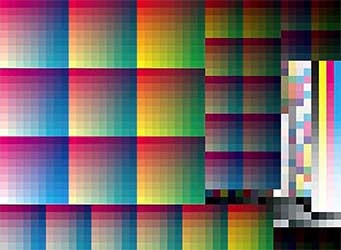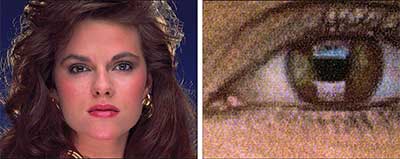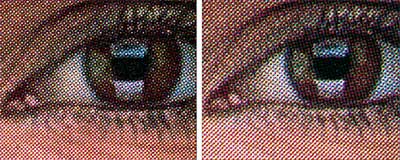|
Color Proofing
Proofing is the critical link between the
graphic production process and printing.
A proof is the visual contract between the
printer and their client. It is the closest
thing to ink on paper, short of firing up the
printing press.
As defined by several online print-provider
websites, ‘a color proof is used to simulate
how the printed piece will look. Because of
differences in equipment, paper, inks, and
other conditions between color proofing
and production pressroom operations,
a reasonable variation in color between
color proofs and the completed job is to
be expected. When variations of this kind
occur, it will be considered acceptable
performance and the proof becomes a
contract between the client and supplier.’
The three leading proofing technologies
are digital halftone, inkjet, and monitor
proofing. These represent the predominate
technologies in most graphic production
departments. They also represent the
majority of SWOP-certified solutions
currently on the market.
Some readers may argue that toner-based
systems should be included on this list.
Although toner-based technology offers
excellent results, it is not widely considered
to be of high enough quality to be used as a contract proof. Color laser proofs are
commonly used as an intermediate proof to
review content and composition.

The ECI2002 standard target containing 1485 color patches, one of several types of targets used to characterize (profile) color printing and proofing devices.
Measuring Quality
One of the most respected venues for
evaluating proof quality is the IPA Color
Proofing RoundUP, conducted annually
at the IPA Technical Conference. The
conference’s organizers evaluated nearly
30 color proofing systems this year, based
on the following criteria:
- Visual match to the GRACoL press sheet
- Colorimetric match (Delta E) to the
press sheet using a IT8.7/4 color target.
Monitor-based systems matched the
L*a*b* SWOP calibration test
- Ability to accurately reproduce
multi-channel images accompanied by
a multi-channel ICC source profile
- Match to specific Pantone solids and
Pantone tints
- Costs of the system and media
Digital Halftone
Digital halftone is the Ferrari of the three
proofing technologies. Digital halftone
systems can cost several times that of
other systems. Likewise, digital halftone
proofs cost many times that of other types
of proofs. However, like the Ferrari, you get
what you pay for.
Most digital halftone devices use laser
thermal imaging to produce a proof. A laser
beam strikes a color-coated donor sheet
causing the colorant to be transferred to
a receiver. The receiver is often a transfer
sheet, or carrier. The image is then
transferred from the carrier to the actual
printing stock or other substrate using a
combination of heat and pressure. Donor
materials are coated with pigment-based
colorant that closely simulates the color
characteristics of printing inks.
Digital halftone proofs replicate the halftone
screening method used for offset printing:
screen ruling, dot shape, dot gain, and
screen angle. Therefore, digital halftone
proofs provide a better indication of printed
detail and the possibility of moiré patterns.
Another major advantage of digital halftone
proofs is their ability to be produced on
the same substrate as the actual printed
piece. This is a significant advantage over
inkjet proofs, which are limited to specially
coated stocks, and as a result must
simulate the actual paper color by altering
the overall color of the proof.
In addition to screening and choice of
substrates, digital halftone devices offer
other unique features such as the ability to
produce true metallic colors and print with
opaque white for use on clear and other
specialized substrates.

Above Left: The original image, part of Kodak’s Colorflow Press Aim Analysis test form. Image © Kodak
Above Right: An extreme enlargement of an EPSON Stylus® Pro 9600 inkjet proof of the image to the left. Note the fine pattern of ink droplets.

Above Left: An extreme enlargement of a Kodak Approval NX™ digital halftone proof of the same image. Note the line screen pattern, which matches the printed sheet to the right.
Above Right: An extreme enlargement of an actual press sheet, printed on a MAN ROLAND 700 printing press at 150 lpi.
Inkjet
Inkjet has become a reliable and widely
accepted alternative to digital halftone
proofing. Not too long ago most printers
would have balked at being asked to
match an inkjet proof on press. However,
over the past five years, advances in
inkjet technology and color management
software have made inkjet a worthy
alternative to digital halftone technology.
In fact, many printers now provide them to
their customers as a contract proof.
Unlike a digital halftone proof, inkjet proofs
do not reproduce the halftone dots. Tiny
droplets of ink are sprayed from a print
head through a series of small nozzles
onto specially coated paper, which dries
immediately. Advances in inkjet technology
allow for near-continuous tone proofs with
dot sizes of 2 picoliters or less.
While digital halftone devices require
highly-specialized lasers, costly pigmented
donors, and proprietary software, inkjet
devices rely on commercially available
color management and RIP technology
to achieve color fidelity. Using ICC
color profiles, inkjet devices can be
‘tuned’ to accurately simulate varying
printing technologies and substrate
characteristics. For a further explanation
of color management and its application to
proofing, please read the second edition of
The Digital Edge, available on our website.
Monitor Proofing
Often referred to as soft-proofing because
of the lack of a physical or ‘hard’ proof,
true contract-quality monitor proofing only
emerged on the scene about four
years ago. ICS’s Remote Director™
became the first SWOP-certified monitorbased
proofing system in January 2003.
Today SWOP has almost 20 certified
monitor-based systems listed on their
website. This year’s IPA Color Proofing
RoundUP featured seven monitor-based
proofing solutions. Three years ago, only
one monitor-based system participated in
the annual event.
Running on commercially available
hardware, monitor-based systems rely on
advanced color management software to
approximate the brightness, color, and
contrast of a printed piece. This is no small
challenge, matching the characteristics of
transmitted light on a monitor to reflected
light from a printed piece. Monitor-based
proofing systems rely on tightly controlled
room lighting and viewing booth conditions
for accurate color evaluation between
screen and printed piece.
Monitor-based proofing systems have the
ability to provide added features such as
real-time remote viewing, collaborative
review, mark-up, and digital sign-off.
The Future of Proofing
Recent technologies such as PDF, CTP,
and digital printing have dramatically
changed the graphic arts industry, which
includes proofing technologies.
A few years ago the list of proofing
technologies would have included analog
technologies such as Cromalin®, Color
Key™, and MatchPrint™. These were used
to proof color-separated films. Similarly, in
a few years this list may not include any
digital ‘hard’ proofing technologies.
Take for example digital printing, where
it is common to print a single piece for
a customer’s approval as opposed to
generating a proof. Printing one piece with
a digital press is much more cost effective
than with a commercial press. There are no
films, no plates, no make-ready, no time
wasted getting the press ‘up to speed’, and
no wash-up afterwards.
Tighter deadline, shorter budgets, global
print procurement, and falling flat-screen
monitor prices will continue to increase the
use of monitor-based proofing for all types
of printing. Standard technologies such as
PDF, JDF, and ICC color management will
ensure end-to-end quality and consistency.
Lastly and most significantly, newcomers to
the industry, more comfortable with digital
media than their ‘analog’ predecessors, will
readily accept monitor-based proofing.
Gary Stafford is the
President of Lazer Incorporated. As a premier graphic communications
provider, Lazer specializes in digital imaging, design and
mechanical layout, electronic prepress, catalog and packaging
development, Digital Asset Management (DAM) and service,
service, service.
Email: garys@lazerinc.com
Company Profile:
Lazer Incorporated
Company URL:
Back to Columns
page
| 


